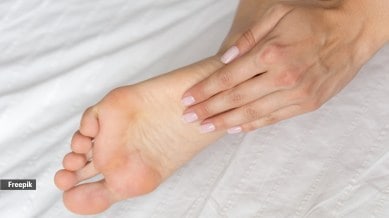📣 For more lifestyle news, click here to join our WhatsApp Channel and also follow us on Instagram
‘Changes in your lower limbs signal…’: Why persistent swelling, cold feet, and sores may indicate heart problems
Excess salt causes the body to retain water, worsening swelling in the feet and ankles.

Our feet and lower limbs often send subtle signals about our overall cardiovascular health, yet many of us overlook them until more serious symptoms appear. Changes such as swelling, persistent coldness, or even sores on the toes and ankles can indicate underlying heart, vascular, or systemic issues that deserve attention.
Dr Kunal Sood, an anesthesiologist and pain medicine physician, highlighted these early warning signs in an Instagram video. He explained, “Changes in your lower limbs often signal what’s happening inside your heart, vessels, or circulation.” While symptoms like cold feet or discolouration may seem minor, Dr Sood warns they can reflect underlying vascular or systemic conditions long before major issues arise.
monthly limit of free stories.
with an Express account.
He elaborated on several key signs:
Varicose veins: “These are dilated, twisted superficial veins caused by weakened valves and poor venous return. They appear as blue or bulging veins on the legs or feet. The CEAP C2 stage defines visible, tortuous veins as a hallmark of varicose vein disease.”
Bilateral ankle swelling: “Bilateral swelling can occur when circulation slows or venous pressure rises. Chronic venous disease causes heaviness, aching, and oedema that worsen with prolonged standing.”
Cold, pale feet with pain while walking: This may suggest poor circulation due to Peripheral Artery Disease. Narrow arteries restrict blood flow, leading to cramping and pain while walking, a condition known as intermittent claudication.
One-sided red, hot, or swollen calf: “Classic signs include one-sided warmth, redness, tenderness, and swelling from venous obstruction. Risk factors include immobility, trauma, cancer, pregnancy, and certain genetic clotting disorders.”
Persistent sores on toes or ankles: “Reduced circulation prevents oxygen from reaching tissues, delaying healing. Non-healing ulcers on the toes, feet, or ankles are warning signs of severe PAD and risk for gangrene if untreated.”
So, can certain dietary patterns or nutrients help improve circulation?
Dr Ravi Prakash, senior consultant cardiology at PSRI hospital, tells indianexpress.com, “Yes, diet plays a significant role in improving circulation and reducing the risk of Peripheral Artery Disease (PAD). A heart-healthy diet rich in omega-3 fatty acids, antioxidants, and fibre can help maintain healthy blood vessels and reduce inflammation.”
He adds that foods such as fatty fish (like salmon and mackerel), walnuts, flaxseeds, and olive oil improve blood flow by lowering triglycerides and reducing plaque buildup in arteries. Leafy green vegetables, berries, and citrus fruits — rich in vitamins C, E, and folate — support vascular elasticity and prevent oxidative damage. Limiting saturated fats, processed foods, and excessive salt is also essential to prevent cholesterol accumulation and maintain good circulation.”
Foods or dietary habits to support healthy circulation and prevent fluid buildup in the lower limbs
To reduce swelling and fluid retention, Dr Prakash says, a balanced diet with limited sodium intake is key. Excess salt causes the body to retain water, worsening swelling in the feet and ankles. Replacing salty snacks with potassium-rich foods like bananas, avocados, spinach, and sweet potatoes helps balance electrolytes and reduce water retention.
Staying well-hydrated is equally important, as dehydration can paradoxically cause the body to hold on to fluid. Including foods high in flavonoids — such as grapes, citrus fruits, onions, and green tea — supports vein strength and improves blood return to the heart. Avoiding alcohol and processed foods can also help control inflammation and fluid imbalance,” mentions the expert.
DISCLAIMER: This article is based on information from the public domain and/or the experts we spoke to. Always consult your health practitioner before starting any routine.
📣 For more lifestyle news, click here to join our WhatsApp Channel and also follow us on Instagram